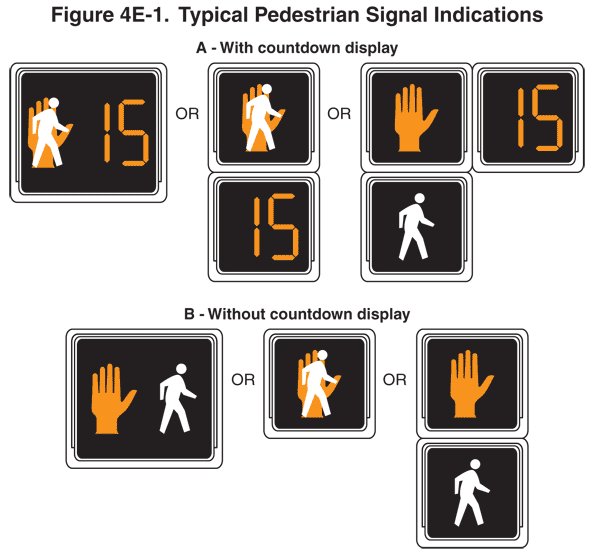2009 Edition Part 4 Figure 4E-1. Typical Pedestrian Signal Indications

Figure 4E-1. Typical Pedestrian Signal Indications
This figure illustrates two examples of typical pedestrian signal indications as they would appear to persons facing the indications.
The first example is labeled "A – With Countdown Display." It shows a solid white walking person symbol superimposed on a solid orange upraised hand symbol to the left of the numeral "15" in orange. The word "OR" is shown to the right of this signal and another signal is shown. It is shown as a two-section signal face, with the sections vertically aligned. A solid white walking person symbol superimposed on a solid orange upraised hand symbol is shown in the top section, and the numeral "15" in orange is shown in the bottom section. The word "OR" is shown to the right of this signal and another signal is shown. It is shown as a three-section signal face, with two sections aligned horizontal and one aligned vertically below the first section. The top left section shows a solid orange upraised hand symbol, the top right section shows the numeral "15" in orange, and the section aligned below the first section shows a solid white walking person symbol.
The second example is labeled "B – Without Countdown Display." It shows a solid orange upraised hand signal to the left of a solid white walking person symbol. To the right the word "OR" is shown and another signal. It is shown as a solid white walking person symbol superimposed on a solid orange upraised hand symbol. To the right of this signal, the word "OR" is shown and another signal. This is shown as a two-section signal face, with the sections vertically aligned. A solid orange symbol of an upraised hand is shown in the top section, and a solid white symbol of a walking person is shown in the bottom section.
